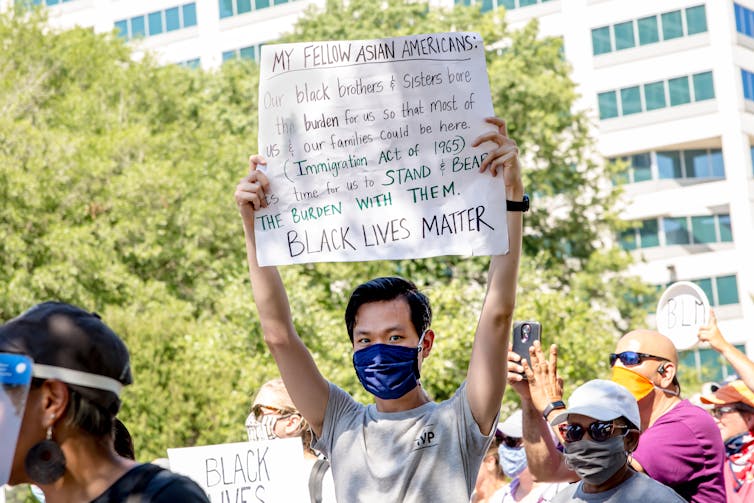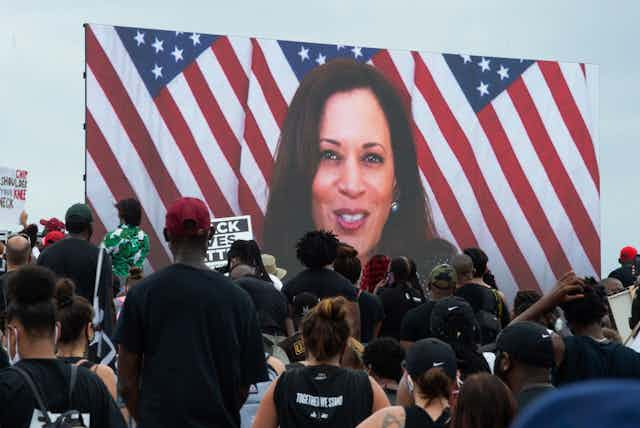Kamala Harris is the daughter of a Jamaican father and Indian mother; she is Black and South Asian. She celebrates both sides of her ancestry, which unites two racial groups that are often seen in the United States as being opposed to each other.
If you’ve heard anything about Black and Asian American relations in the U.S., what you’ve heard likely focuses on hostility and conflict between the two groups.
In electoral politics, research on multiracial legislators indicates that those with dual nonwhite backgrounds like Harris have the potential to serve as bridges between groups and use their backgrounds to influence policy that serves multiple communities.
Harris’ nomination as Joe Biden’s vice presidential running mate is an opportunity to understand the history of the relationship between America’s Black and Asian communities. It’s also a time to consider the possibility for political coalition building between Blacks and Asian Americans in this moment when racial discrimination is an urgent subject for much of the country.
Racial triangulation
The 1991 killing of a Black 15-year-old named Latasha Harlins by a Korean store clerk, and the violent unrest in Los Angeles that was partially stoked by that killing, are perhaps the most prominent instances and depictions of violence and conflict between Black and Asian American communities.
Similar dynamics continue today. For example, one of the police officers involved in the killing of George Floyd, Tou Thao, is a Hmong American with a history of use of excessive force charges. Floyd’s murder bolstered calls from Asian American communities to address Asian anti-Blackness.
We’d argue that Black and Asian American people are pitted against each other by media, government and society to maintain the United States’ social hierarchies.
When dismissing Black people as stereotypically “lazy” or “deviant,” media commentators and lawmakers often use stereotypes of Asian Americans to bolster their claims. They stereotype Asian Americans as a model minority who are “diligent” workers who have “respect for authority.”

At the same time, Asian Americans are treated as “foreigners” whose citizenship is fair game for questioning. This is especially true for those with darker skin and more recent immigration histories, such as Hmong and Filipinos.
Japanese internment during World War II, for instance, is one example in which Japanese Americans were considered security threats to the United States. They were forced by the federal government, through various methods, from their homes into camps. Today, Japanese Americans, many survivors of those internment camps, are active in opposing immigrant detention centers through the national “Never Again Is Now” Jewish-led movement.
Black and Asian American common cause
Yet despite the stereotypes of these two communities in opposition to each other, Black and Asian American communities have historically had close political relationships, drawing on shared struggles to build solidarity. These connections are also mirrored on a personal level.
People who identify as Black and Asian on the U.S. Census are among the fastest-growing groups of people who identify with two or more races on the U.S. Census. As Myra Washington, a communications scholar who writes about Blasians, or people who are Black and Asian, shows in “Blasian Invasion: Racial Mixing in the Celebrity Industrial Complex,” the existence of Black-and-Asian people predates multiracial recognition on the 2000 Census.
Interracial marriage is increasingly common, although intermarriage between Black and Asian American communities is not new. Between the 1880s and early 1900s, South Asian men working on British ships abandoned those ships in Louisiana and New York and worked as “peddlers” in New Orleans and New York City. Some intermarried with women from Black communities, such as when Bengali Muslim trader Moksad Ali married African American Ella Blackman in New Orleans in 1895.
Black feminist scholars like Kimberlé Crenshaw use the notion of identities as de facto coalitions. This means that individuals can use their identities, such as race, gender, sexual orientation and class, and their stature within their own communities to build relationships between groups.
Among the most famous friendships and political connections between Asian American and Black political movement leaders was between Japanese American political activist Yuri Kochiyama and Black radical Malcolm X.
Kochiyama’s politics were deeply influenced by her imprisonment in a Japanese internment camp during World War II. She consequently became radicalized upon meeting Malcolm X. She built relationships with those engaged in Black struggles including defending political prisoners, but also worked with other groups such as Puerto Ricans in their struggles against police violence, for better schools and dignified housing for all working-class communities.
American wars have also inspired solidarity between Black Americans and Asians globally. During the Philippine-American War waged from 1899 to 1902, some Black troops known as the Buffalo Soldiers saw similarities between American anti-Black racism and American treatment of Filipinos. A number of them defected from the United States to fight alongside Filipinos.
During the Vietnam War, anti-racism activist and boxer Muhammad Ali famously protested against deployment to Vietnam, saying that Vietnamese people did not subjugate him to the anti-Black racism he experienced in the United States.
And the assassination of Martin Luther King Jr. came at a moment where his stances against U.S. imperialism and the Vietnam War were taking central stage on his agenda.
[Deep knowledge, daily. Sign up for The Conversation’s newsletter.]
Potential for coalition building
Today, Black and Asian American communities may find common ground on the issues of policing and immigration. Although policing may commonly be thought of as a “Black issue” and immigration commonly thought of as an “Asian (or Latinx) issue,” public opinion paints a more complex picture.
Data from the African American Research Collective shows that in 2018, 76% of Black survey respondents believed that “immigrants just want to provide a better life for their families, just like you and me.”
In 2016, 49% of Asian American respondents to the National Asian American Survey expressed very favorable or somewhat favorable feelings toward Black Lives Matter. Korean Americans expressed the greatest favorability, at 73%.
However, Black and Asian Americans are not homogeneous groupings. Segments of Indian Americans, for example, support the Trump administration’s immigration policies that favor highly skilled workers. Yet the issuance of these visas is limited due in part to legacies of racial animus toward Indian immigrants.
Much of the discussion about Kamala Harris has focused on her background in law enforcement, her identity as a multiracial woman, the contradictions between her platform and identities, and the meaning of these for community trust in her leadership.
Harris in essence may become a mirror for these communities to reflect on the ways their two groups have been historically divided by government policy and social tensions.
And her selection may also offer the opportunity for members of the two communities to consider grassroots coalition building on issues – beyond electoral politics – that affect their everyday lives.

